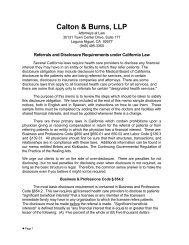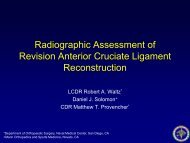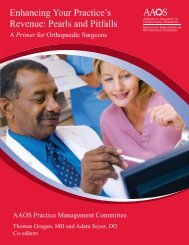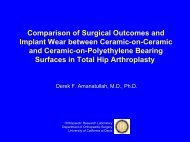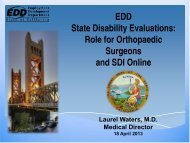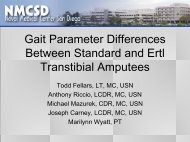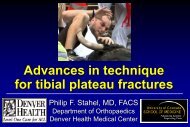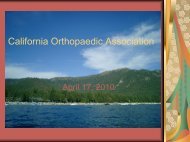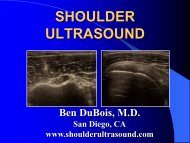Judge Allyson Hall - California Orthopaedic Association
Judge Allyson Hall - California Orthopaedic Association
Judge Allyson Hall - California Orthopaedic Association
Create successful ePaper yourself
Turn your PDF publications into a flip-book with our unique Google optimized e-Paper software.
Curriculum Vitae<strong>Allyson</strong> <strong>Hall</strong>• WCJ at the Stockton WCAB District Office since 12/2006• Adjunct Professor of Law—Humphreys Law School• Certified Specialist in Workers’ Compensation Law• CA State Bar Specialization Exam Grader• Stockton WCAB Bench and Bar Coordinator• Private Practice 1996-2006• J.D. Pacific McGeorge School of Law----1996• LL.M. in Transnational Business Practice• Pacific McGeorge School of Law----2007
DisclaimerThe opinions expressed by the speaker on thistopic are her own and are not endorsed by orrepresent the opinions or policies of theDepartment of Industrial Relations, other judgesor the WCAB commissioners.
Your goal in writing reports• Your report should constitute substantialevidence• In order to be followed, a medical reportmust constitute substantial evidence
WCAB’s Definition ofSubstantial Evidence• “A A medical report is not substantialevidence unless it sets forth the reasoningbehind the physician’s s opinion, not merelyhis or her conclusions.” Granado v.WCAB (1970), 69 Cal.2d 399.• Why not? Don’t t we ultimately rely on aphysician’s s overall conclusions????
WCAB’s Definition ofSubstantial Evidence• “In order to constitute substantial evidence, amedical opinion must be predicated onreasonable medical probability.” McAllister v.WCAB (1968) 69 Cal.2d 408.• “A A medical opinion is not substantial evidence ifit is based on facts no longer germane, oninadequate medical histories or examinations,on incorrect legal theories, or on surmise,speculation, conjecture, or guess.” Hegglin v.WCAB (1971) 4 Cal.3d 162.
WCAB’s Definition ofSubstantial Evidence• Because…• “The chief value of an expert’s s testimony restsupon the material from which his or her opinionis fashioned and the reasoning by which he orshe progresses from the material to theconclusion, and it does not lie in the mereexpression of the conclusion; thus, the opinion ofan expert is no better than the reasons uponwhich it is based.”• People v. Bassett (1968) 69 Cal.2d 122.
What ConstitutesSubstantial Evidence?The evaluator’s s focus
Substantive Considerations• The type and form of the evidencepresented• Documentary versus other evidence• Oral testimony• Lay testimony• Expert testimony
Workers’ CompensationCasesRelevant cases for Medical-LegalEvaluators
Minniear v. Mt San Antonio CommunityCollege District, (1996) 61 CCC 1055(en banc)• With regard to medical opinion presumedcorrect, such opinion may be overcome bya preponderance of medical opinionindicating a different conclusion.• Evidence from a lay witness on an issuerequiring expert opinion is not substantialevidence.
Kopping v. WCAB, (2006) 71CCC 1229 (3 rd Dist.)• With regard to apportionment, Labor Codesection 4464(b) creates a conclusivepresumption of the continued existence ofPD where the claimant received a prior PDAward.
Escobedo v. Marshalls, (2005) 70 CCC604 (en banc)• It is well established that any decision of theWCAB must be supported by substantialevidence.• To constitute substantial evidence, a medicalopinion must be predicated on reasonablemedical probability.• It must be based upon germane facts.• It must be based upon an adequate history.
Escobedo v. Marshalls, (2005) 70 CCC604 (en banc)• To be substantial evidence, a medicalopinion must be based upon an adequateexamination.• The medical opinion must not be basedupon incorrect legal theories.• It cannot be based upon surmise,speculation, conjecture, or guess.
Escobedo v. Marshalls, (2005) 70 CCC604 (en banc)• To constitute substantial evidence, the medicalopinion must set forth the reasoning behind theopinion, not merely state conclusions.• The expert must provide the material from whichhis or her opinion is fashioned and provide thereasoning by which he moved from the materialto conclusions.
Escobedo v. Marshalls, (2005) 70 CCC604 (en banc)• In summary, to be substantial evidence,medical opinion must be framed in termsof medical probability, must not bespeculative, must be based upon pertinentfacts, history and examination, and it mustset forth reasoning in support of itsconclusions.
Almaraz v. Environmental Recovery Services,(2009) 74 CCC 1084 (en banc) – Almaraz/GuzmanII• A PD rating established by the PDRS isrebuttable.• The burden of rebutting the PDRS rests with theparty disputing the rating.• WPI under the AMA Guides may be challenged.• One cannot go outside four corners of the AMAGuides to determine WPI.
Almaraz v. Environmental Recovery Services,(2009) 74 CCC 1084 (en banc) – Almaraz/GuzmanII• A physician may utilize any chapter, table, ormethod in the AMA Guides that most accuratelyreflects the injured employee’s s impairment.• A physician may not use any chapter, table, ormethod in the AMA Guides simply to achieve adesired result such as to approximate PD undera prior schedule.
Almaraz v. Environmental Recovery Services,(2009) 74 CCC 1084 (en banc) – Almaraz/GuzmanII• The physician’s s opinion under the AMA Guidesmust set forth the facts and reasoning justifyingit.• An opinion cannot be arbitrary. The report mustbe clear, accurate, and complete and explain theimpairment conclusions.• The opinion must be substantial evidence uponwhich the WCAB can rely, citing Escobedo.• A WPI not based on the AMA Guides is notsubstantial evidence.
Almaraz v. Environmental Recovery Services,(2009) 74 CCC 1084 (en banc) – Almaraz/GuzmanII• Process: A PTP, AME or QME offers anopinion regarding the injured worker’s s WPIunder the AME Guides.• Injured worker or defendant may challengethat opinion through rebuttal evidence,generally through a deposition or asupplemental report.
Almaraz v. Environmental Recovery Services,(2009) 74 CCC 1084 (en banc) – Almaraz/GuzmanII• The burden of rebutting the schedule rests withthe party disputing the rating.• Once all evidence relating to permanentdisability has been presented, including both theoriginal and rebuttal evidence on WPI, TheWCAB determines the percentage of PD.• In this regard, it is the WCAB and not anyparticular physician that is the ultimate trier offact on medical issues. Remember: the judge isthe audience.
Substantial Evidence—is is it aconcrete or fluid concept?• Whether the particular portions of therecord are substantial evidence at anygiven time can change depending therecord’s s development and the litigationprocess.
In the beginning—the Injury• Don’t t forget the Best Evidence Rule• What evidence is more probative on theissue of injury?• Employer records• Witness statements• accident reports/police records• Ambulance records
Why attorneys depose expertsEstablishes the expert’s s opinion.Establishes the expert’s s assumptions andunderstanding of the lawEstablishes the expert’s s reasoningTests the expert’s s assumptionsTests the legal underpinnings of the conclusionsthe expert reachedTests the progression from fact to the expert’sopinion
Depositions of Physicians• Review of records• Review of actual films• Extent of reliance on injured worker’shistory• Understanding of AMA Guides, Almaraz,Escobedo, etc.• Examination procedures• Credibility of Applicant
Other Considerations inDepositions of Physicians• Establish qualifications and certifications(establishes credibility)• Determine bias (whose side is he or she on?Objectivity?)• Discredit or confirm the validity of the expertopinion• Determine whether the theory of the case can besupported by the expert’s s calculations
The Good, The Bad,& the UglyWhere does your report fit in?
Good Report? What’s s that?• A complete history is taken of the applicant and reviewedby the evaluating physician AND is clearly andcompletely summarized and contained in the body of thereport.• A complete records review BY THE EVALUATINGPHYSICIAN is completely summarized and contained inthe body of the report.• A cogent and well-supported discussion ofapportionment (based on valid, measurable grounds) isin the report. Reasonable medical probability goesbeyond speculation. Conclusions must be justified byreferences to the record.• Does not contain errors in BAD or UGLY reports(discussed below)
Bad report? What’s s that?• Some records reviewed, but by history, not allrelevant records are available for review (but thereport is still completed and served containing adetermination of all the issues). Rule 35(i)requires issuance of the report but a notationthat the records were not received.• Incomplete report (see above).• No physical examination findings ormeasurements are outlined in the report.• Other evaluations required for which the QME isnot qualified to perform are not identified in thereport. (Rule 31.7(b)
Ugly report? What’s s that?• No records review• No face to face time identified• No 139.5 declaration• Not signed under penalty of perjury, OR• No signature at all• No proof of service• Report is late without time extension request(could get reported to the AD or MedicalDirector—see Rule 38)
Legal Requirements for Med-LegalReports• Summary form (see LC sec. 4062.3(i)• Date of report (if different from exam) (Rule 35.5(b))• List of information received (LC sec. 4062.3(d)• Information received from the parties• Information reviewed in preparation of the report• Information relied upon in the formulation of the medical opinion.n.• Apportionment determination (Rules 4663 & 4664)• Records review• A medical report is not substantial evidence unless there is areview of all relevant records (Kyles(v. WCAB 52 CCC 479)• All contested medical issues addressed (Rule 35.5(c))
Pitfalls to Avoid• Ex parte communications with any party(in violation of Rule 35/LC sec. 4062.3(e),(f))• Failure to issue report timely (Rule 38(a))• Failure to request an extension of timewith the AD (Rule 38(c))• Failure to be available for deposition (inviolation of Rule 35.5)
Additional Considerations• Do you require an interpreter to take anadequate history?• Are there additional evaluations requiredbefore you can make a completedetermination of all the relevant issues?• Did you review the medical recordsyourself?• Did you review and sign your report?• (Avoid the “Dictated but not read” problem)
Fin




